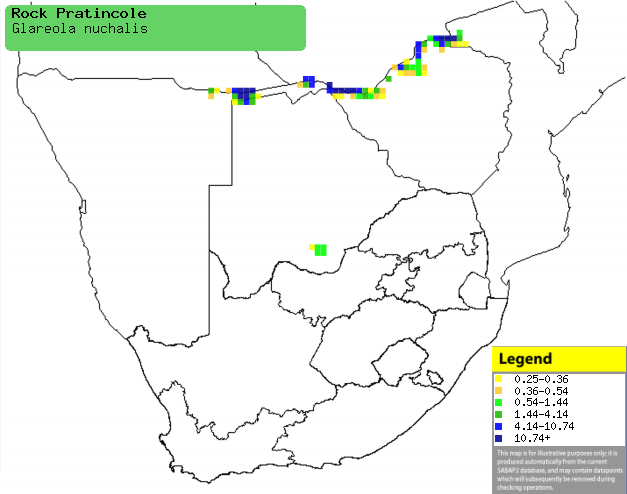|
Glareola nuchalis (Rock
pratincole)
Withalssprinkaanvoël [Afrikaans];
Rotsvorkstaartplevier [Dutch]; Glaréole auréolée [French];
Halsband-brachschwalbe, Weißnacken-brachschwalbe [German]; Perdiz-do-mar-escura
[Portuguese]
Life
> Eukaryotes >
Opisthokonta
> Metazoa (animals) >
Bilateria >
Deuterostomia > Chordata >
Craniata > Vertebrata (vertebrates) > Gnathostomata (jawed
vertebrates) > Teleostomi (teleost fish) > Osteichthyes (bony fish) > Class:
Sarcopterygii (lobe-finned
fish) > Stegocephalia (terrestrial
vertebrates) > Tetrapoda
(four-legged vertebrates) > Reptiliomorpha > Amniota >
Reptilia (reptiles) >
Romeriida > Diapsida > Archosauromorpha > Archosauria >
Dinosauria
(dinosaurs) > Saurischia > Theropoda (bipedal predatory dinosaurs) >
Coelurosauria > Maniraptora > Aves
(birds) >
Order: Charadriiformes > Family: Glareolidae
Distribution and habitat
Occurs in sub-Saharan Africa from Senegal to the DRC south
through Angola and Zambia to southern Africa. Here it is uncommon in the far
north of the region in the Caprivi Strip (Namibia), north-western Zimbabwe and northern
Botswana. It generally prefers large perennial rivers with small rocky islets,
especially with deep fast-flowing water.
|
 |
|
Distribution of Rock pratincole in southern Africa,
based on statistical smoothing of the records from first SA Bird Atlas
Project (©
Animal Demography unit, University of
Cape Town; smoothing by Birgit Erni and Francesca Little). Colours range
from dark blue (most common) through to yellow (least common). |
Movements and migrations
Intra-African migrant, arriving in southern
Africa in August to breed before eventually departing in December
and January. The location of its non-breeding grounds unknown but
are probably in equatorial Africa.
Food
It mainly eats insects, doing most of its foraging aerially
over water at dawn and dusk, especially after rains. The following food items have been recorded
in its diet:
Breeding
- Monogamous, solitary or loosely colonial nester, sometimes breeding in
colonies of 2-16 pairs with additional non-breeding birds.
- Typically lays its eggs on a rock ledge, under an overhang, in a hole
in rock or a flat boulder, provided that there is shade for at least part of
the day.
- Egg-laying season is from August-November, peaking in October.
- It lays 1-2 eggs, which are incubated by both sexes for about 20 days,
in shifts of about an hour.
- The chicks are cared leave the nest within 1-2 days of hatching, finding
cover in nearby foliage where the parents feed them by regurgitation. They
fledge at about 20-30 days old, becoming fully independent roughly three
months later.
Threats
Of high regional conservation concern in southern Africa,
largely caused by the creation of dams which either flood or drain the water
level of the rivers it is dependent on.
References
-
Hockey PAR, Dean WRJ and Ryan PG 2005. Roberts
- Birds of southern Africa, VIIth ed. The Trustees of the John Voelcker
Bird Book Fund, Cape Town.
|
